The very first police packages—defined as a set of options and features installed at the factory, engineered specifically for police duty—were issued by Plymouth, and quickly imitated by Dodge and others. For a time, the police market was dominated by Chrysler Corporation, even though it was a marginal player in most other segments; and the streets were patrolled by the Fury, Monaco, St. Regis, Diplomat, and Gran Fury, depending on the year. In Canada, the Volare was mildly popular on patrol; even the Valiant had a police package for a brief time. Chrysler’s share of the police market ranged from 45% to a stunning 80% from the mid-1960s to the early 1980s.
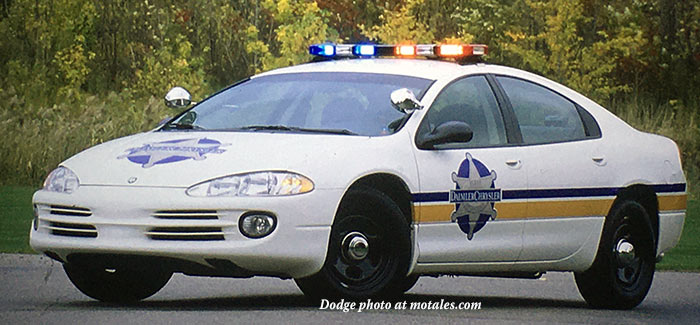
The 2002 Dodge Intrepid pursuit car should have been a winner; it could keep up with the V8 Ford Crown Victoria “Police Interceptor,” while getting far better gas mileage, with a capacious interior and enviable cornering. The “LH” car never had more than a small following, though; even the Jeep Cherokee pursuit package seemed to be more popular.
The Intrepid was the first Dodge pursuit vehicle since the final “M-body” Diplomat and Gran Fury left the factory in 1989. Its 3.5 liter V6 engine produced far more power than the old M-bodies ever had; a typical 318 Diplomat was good for 130 horsepower, while the Intrepid had a standard 242 horsepower (at 6,400 rpm). Torque was good, too, with 248 pound-feet (at 3,950 rpm).
Pete Kranz pointed out more Diplomat/Gran Fury specs for a better comparison. The BBD two-barrel 318 used from 1981-84 produced 130 horsepower, 230 pound-feet of torque; the Carter ThermoQuad carb package raised that to 165 hp, 240 lb-ft, both figures still well below the Intrepid. From 1985 to 1989, the ELD 318, with a two-barrel Holley, hydraulic roller lifters, and updated heads, produced 140 hp and 265 lb-ft of torque; the top engine, the ELE 318 with a four-barrel Quadrajet, produced a respectable 175 hp and 250 lb-ft of torque.
The pursuit package was more than just putting the most powerful LH engine into the Intrepid; it had a tweaked high-performance suspension, heavy-duty four-wheel disc brakes with antilock, special lighting, and a severe duty cooling system. During severe-duty testing, though, though it was rare on the street, the brakes leaked some fluid which caught fire—a problem which brought Chrysler’s long-time police car expert out of retirement to specify a silicone-based brake fluid. That solved the problem late in the model run, but the damage to the car’s reputation may have been too much to overcome.
The main problem was that the car was front wheel drive; and most police departments refused to accept that from GM or Chrysler, though when Ford provided front drive cars, they were almost instantly accepted. A similar scenario was to play out with SUVs; the Cherokee was a fine police car, but it took Ford’s Explorer to really break SUVs into the mix.
There were other problems, according to Pete Kranz: low ground clearance, the water pump (which was fine for civilian use but could fail under police conditions), and the transmission solenoid packs (again, generally fine for civilians but a weak point for the police). More to the point, from the officers’ point of view:
One may ask how it all worked out. In terms of sales, the Dodge Intrepid police car was a failure; it was only made from 2002 to 2004, and ended up with a mere 4% market share despite high performance and a great deal of interior space. Acceleration was tested to be on par with the V8 Crown Victoria (0-60 in 8.72 seconds vs the Ford V8’s 8.42 and the Impala’s 9.21), but the Intrepid could easily out-corner the old Fords. The low sales was no doubt a disappointment to Dodge, which had spoken with police officers throughout the country, one-on-one, to find what they wanted; and the price was similar to the Crown Victoria. In fairness, having it on the market for just two years may have been a problem, given the conservative nature of many purchasing officers, and the highly public transmission failures of the four-speed in 1989-91.
Among police officers, there was general agreement that the Intrepid was better than the front-drive Chevy Impalas; they felt that the Ford V8 did not have enough low-end torque, too, and officers missed the rear-drive LT1 Caprice, which had much more low-end torque. On the other hand, some departments liked the Impala’s tough cradle which protected front end running gear, keeping the cars intact when jumping curbs and medians at speed. GM had learned from the 1970s police cars, where Mopars, by being the tough ones, had dominated the high-profile NYPD contracts. Hitting a curb at high speed in the Intrepid could kill a CV joint, putting the car out of action. Police were also taught in rear drive cars, learning techniques such as using the oversteer.
FLAMING BRAKES? Pete Kranz pointed out that the big mistake on the Intrepid pursuit package was using brakes that had tested well at the track, in a more demanding (for brakes) environment where heat built up more dangerously. The pads overheated, transferring their heat to the calipers, whose seals then allowed the brake fluid out; the first company answer to this was swapping the pads, calipers, and rotors. Pete added, “having learned absolutely nothing, the same exact thing happened with the 2005 Magnum and 2006 Magnum and Charger police models. And once again, a change to heavier calipers, severe duty pads, and revised ABS/ESC calibrations helped. It was not until mid-2014, when the huge BR9 brakes appeared in the squads, that braking concerns evaporated.”
The size and placement of the pedals was a “ding,” since they were different from the cars most police were used to, and the Michigan State Police noted that as a problem. Otherwise the ergonomics were quite good, and the interior space was both larger and more accessible. The interior was somewhat noisy, apparently noisier than in a standard car since the suspension was stiffer and transmitted noise and vibration more easily; the Fords were similar and tended to shake and rattle quite a bit after around 30,000 miles.
While the 2002 Ford V8 was the fastest of the three to hit 60 and posted the best quarter mile (16.4@87), the Dodge was close behind (16.7@85); and it had a higher top speed (135 vs 129 mph). Torque steer was reportedly not an issue. The 2003 Ford was actually a little slower, having body reinforcements to deal with safety issues in the older models. For 2004, the numbers were a little different (Ford had two ratios, a 3.27:1 and a 3.55:1), with Ford having the best 0-60 and 0-100 but equal course times and not-quite-as-good braking as the Dodge—or the earlier Fords:
| Dodge | Ford | Ford | Chevrolet | |
|---|---|---|---|---|
| 0-60 | 8.56 | 8.25 | 8.44 | 9.00 |
| 0-100 | 23.6 | 22.5 | 23.3 | 26.4 |
| Top speed | 135 | 128 | 123 | 123 |
| Braking (ft) | 137 | 150 | 150 | 134 |
| MPG | 22 | 18 | 18 | 23 |
| Course (sec) | 1:42 | 1:42 | 1:42 | 1:45 |
The slightly better acceleration of the V8 did not compensate for handling or Dodge’s better braking. All four cars ended the course at around the same time, but the Fords turned in far lower gas mileage, and that longer stop could get someone killed.
The Dodge Intrepid police car listed at $23,800, including destination, and was built starting in January 2002 at the Brampton (Ontario) plant, where all the LH cars were made. Special equipment included:
 Dodge Intrepid: the police car
Dodge Intrepid: the police car
Agile, surprisingly quick front while drive pursuit vehicles
 Plymouth police cars of 1976
Plymouth police cars of 1976
Downsized but strong
 Car Spotter: 1971 Plymouth Fury Pursuit Car
Car Spotter: 1971 Plymouth Fury Pursuit Car
Big and classy police car
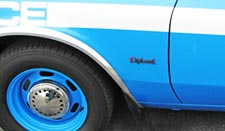 Making police cars: who and what was involved?
Making police cars: who and what was involved?
Diving into the changes that make an ordinary car into a pursuit vehicle (or just an ordinary police car)
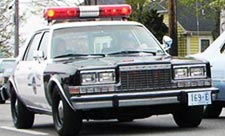 Prototypical police cars: Dodge Diplomat and Plymouth Gran Fury
Prototypical police cars: Dodge Diplomat and Plymouth Gran Fury
Inside the M-body Dodge Diplomat and Plymouth Gran Fury that defined how police cars should look for at least a decade
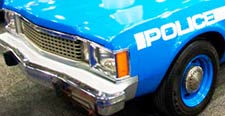 Mopar police cars of 1980: St. Regis/Gran Fury, Aspen/Volare, B-Van
Mopar police cars of 1980: St. Regis/Gran Fury, Aspen/Volare, B-Van
The last of the big Plymouth and Dodge police cars, in their penultimate year, with the final F-body squads
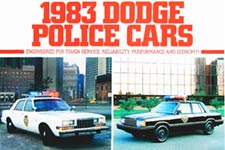 Mopar police cars of 1983: Diplomat/Gran Fury and Reliant/Aries
Mopar police cars of 1983: Diplomat/Gran Fury and Reliant/Aries
Two quite different approaches to police cars, with front and rear wheel drive, powered by V8 and four-cylinder engines
Copyright © 2021-2025 Zatz LLC • Chrysler / Mopar car stories and history.
YouTube • Editorial Guidelines • Videos
Tailfins Archive • MoTales on BlueSky